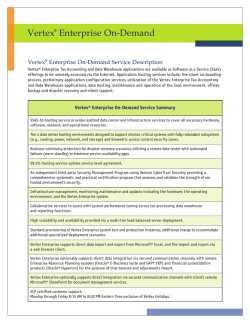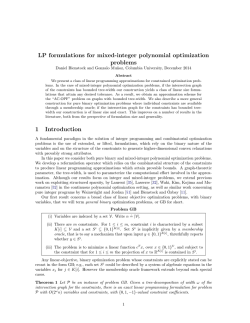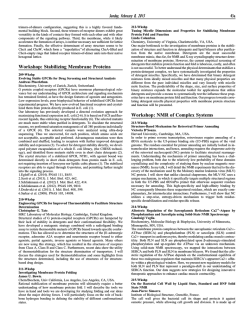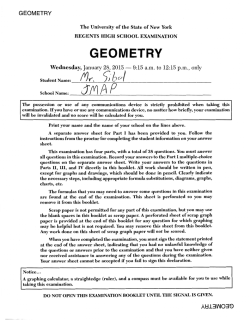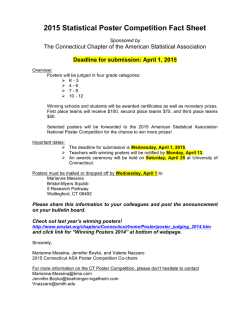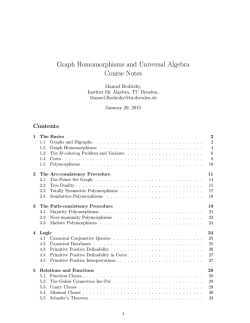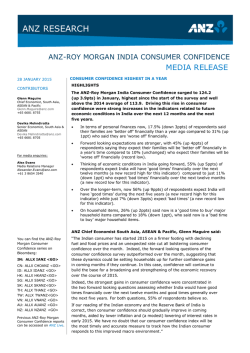
Efficient Search Space Exploration for HW
Efficient Search Space Exploration for HW-SW Partitioning † Sudarshan Banerjee Nikil Dutt Center for Embedded Computer Systems University of California, Irvine, CA, USA [email protected] [email protected] ABSTRACT graph DAG (directed acyclic graph) extracted from a sequential application written in ’C’ or any other procedural language, where the graph vertices represent functions, and the graph edges represent function calls or accesses between functions. In this paper, we make two contributions to HW-SW partitioning. First we prove that for a callgraph representation, when a vertex is moved to a different partition, it is only necessary to update the execution time change metric [6] for its immediate parents and immediate children instead of all ancestors along the path to the root. This in general allows for a more efficient application of movebased algorithms like simulated annealing (SA). Second, we present a cost function for simulated annealing to search regions of the solution space often not thoroughly explored by traditional cost functions. This enables us to frequently generate more efficient design points. Our two contributions result in a very fast simulated annealing (SA) implementation that generates partitionings such that the application execution times are often better by over 10% compared to a KLFM (Kernighan-Lin/Fiduccia-Matheyes) algorithm for HWSW partitioning for graphs ranging from 20 vertices to 1000 vertices. Equally importantly, graphs with a thousand vertices are processed in much less than a second. Hardware/software (HW-SW) partitioning is a key problem in the codesign of embedded systems, studied extensively in the past. One major open challenge for traditional partitioning approaches – as we move to more complex and heterogeneous SOCs – is the lack of efficient exploration of the large space of possible HW/SW configurations, coupled with the inability to efficiently scale up with larger problem sizes. In this paper, we make two contributions for HW-SW partitioning of applications represented as procedural callgraphs: 1) we prove that during partitioning, the execution time metric for moving a vertex needs to be updated only for the immediate neighbours of the vertex, rather than for all ancestors along paths to the root vertex; consequently, we observe faster run-times for move-based partitioning algorithms such as Simulated Annealing (SA), allowing call graphs with thousands of vertices to be processed in less than a second, and 2) we devise a new cost function for SA that allows frequent discovery of better partitioning solutions by searching spaces overlooked by traditional SA cost functions. We present experimental results on a very large design space, where several thousand configurations are explored in minutes as compared to several hours or days using a traditional SA formulation. Furthermore, our approach is frequently able to locate better design points with over 10 % improvement in application execution time compared to the solutions generated by a Kernighan-Lin partitioning algorithm starting with an all-SW partitioning. Categories and Subject Descriptors: B.6.3 [C.0] General Terms: Algorithms Keywords: HW-SW partitioning, dynamic cost function 1. 2. RELATED WORK HW-SW partitioning is an extensively studied ”hard” problem with a plethora of approaches- dynamic programming [11], genetic algorithms [3], greedy heuristics [10], to name a few. Most of the initial work, [11], [12], focussed on the problem of meeting timing constraints with a secondary goal of minimizing the amount of hardware. Subsequently there has been a significant amount of work on optimizing performance under area constraints, [1], [2], [6]. With the goal of searching a larger design space, techniques such as simulated annealing (SA) have been applied to HWSW partitioning using fairly simple cost functions. While a lot of initial work such as [12] was based exclusively on SA, recent approaches commonly measure their quality against a SA implementation. For example, [1] compares simulated annealing with a knowledge-based approach, and [2] compares SA with tabu search. It is well-known that SA requires careful attention in formulating a cost function that allows the search to ”hill-climb” over suboptimal solutions. However, much of the published work in HW-SW partitioning have not studied in detail the SA cost functions that permit a wider exploration of the search space. As an example, in [2], [7], the SA formulation considers only valid solutions satisfying constraints, thus restricting the ability of SA to ”hill-climb” over invalid solutions to reach a valid better solution. The two previous pieces of work in HW-SW partitioning that are most directly related to our work are [6], [4]. Our model for HWSW partitioning is based on [6], a well-known adaptation of the INTRODUCTION Partitioning is an important problem in all aspects of design. HW-SW (hardware-software) partitioning, i.e, the decision to partition an application onto hardware (HW) and software (SW) execution units, is possibly the most critical decision in HW-SW codesign. The effectiveness of a HW-SW design in terms of system execution time, area, power consumption, etc, are primarily influenced by partitioning decisions. In this paper, we consider the problem of minimizing execution time of an application for a system with hard area constraints. We consider an application specified as a call †This work was partially supported by NSF Grants CCR-0203813 and ACI-0205712 Permission to make digital or hard copies of all or part of this work for personal or classroom use is granted without fee provided that copies are not made or distributed for profit or commercial advantage and that copies bear this notice and the full citation on the first page. To copy otherwise, to republish, to post on servers or to redistribute to lists, requires prior specific permission and/or a fee. CODES+ISSS’04, September 8–10, 2004, Stockholm, Sweden. Copyright 2004 ACM 1-58113-937-3/04/0009 ...$5.00. 122 memory v0 v4 v6 SW access to the callee function v j from the caller function vi . The SW execution times and callcounts are obtained from profiling the application on the SW processor. In this model, the HW execution time and the HW area for the functions are estimated from synthesis of the functions on the given HW unit. The simple model for HW area estimates assumes that the area of a cluster of components can be obtained by summing the individual HW areas. Communication time estimates are made by simply dividing the volume of data transferred by the bus speed. Since the execution time model is sequential, bus contention is assumed to play an insignificant role. Each edge ei j has 2 weights (cci j , cti j ). cci j represents the call count, i.e, the number of times function v j is accessed by its parent vi . cti j represents the HW-SW communication time, i.e, if vi is mapped to SW and its child v j is mapped to HW (or vice-versa), cti j represents the time taken to transfer data between the SW and the HW unit for each call. (Note: we assume that vertices mapped onto the same computing unit have negligible communication latency) Each vertex vi has 3 weights (tis , tih , hi ). tis is the execution time of the function corresponding to vi on the SW unit (processor). tih and hi are the execution time, and, area requirement, respectively for the function on the HW unit. Note that in this work we do not consider compiler (synthesis) optimizations leading to multiple HW implementations with different area and timing characteristics. A partitioning of the vertices can be represented as P = {vs0 , vh1 , vs2 .....}. This denotes that in partitioning P, vertex v0 is mapped to SW, v1 is mapped to HW, v2 is mapped to SW, etc. Two key attributes of a partitioning are (T P , H P ). T P denotes the execution time of the application under the partitioning P, H P denotes the aggregate area of all components mapped to hardware under partitioning P. HW local memory HW v3 v1 v2 Figure 1: Target architecture SW v5 HW Figure 2: Simple callgraph KL paradigm for HW-SW partitioning; our efforts in improving the quality of the cost function are closely related to [4]. Our partitioning granularity is similar to [6], effectively that of a loop-procedure call-graph; each partitioning object represents a function and the DAG edges are annotated with callcounts. [6] introduced the notion of execution time change metric for a DAG, and updating the metric potentially by evaluation of ancestors along the path to the root. The linear cost function in [6] ignores the effect of HW area as long as the area constraint is satisfied. [4] provides an in-depth discussion of cost functions and the notion of improving the results obtained from a simple linear cost function by dynamically changing the weights of the variables. We differ from [4] in the following ways: [4] addresses the problem of choosing a suitable granularity for HW-SW partitioning that minimizes area while meeting timing constraints; since we consider the problem of minimizing execution time while satisfying HW area constraints, the proposed cost function in [4] needs significant adaptation for our problem. In [4], the dynamic weighting technique was applied towards the secondary objective of minimizing HW area once the primary objective, the timing constraint, was almost satisfied. We however, apply a dynamic weighting factor to our cost functions in various regions of the search space to better guide the search. Last but not the least, since their primary focus was on the granularity selection problem, there was no quantitative comparison of their approach with other algorithms- we have compared our approach to the KLFM approach with an extensive set of test cases and demonstrated the effectiveness of our approach. 3. 4. EFFICIENT COMPUTATION OF EXECUTION TIME CHANGE METRIC Given a sequential execution paradigm and a call-graph specification, the execution time of a vertex vi is computed as the sum of its self-execution time and the execution time of its children. The execution time for vi additionally includes HW-SW communication time for each child of vi mapped to a different partition. Thus, if TiP denotes the execution time for vertex vi under a partitioning P, PROBLEM DESCRIPTION We consider the problem of HW-SW partitioning of an application specified as a callgraph extracted from a sequential program written in C, or, any other procedural language. For the purpose of illustrating the basic partitioning formulation, we assume a simple target architecture that contains one SW processor and one HW unit connected by a system bus, as shown in Figure 1. 1 We assume mutually exclusive operation of the two units, i.e, the two units may not be computing concurrently. We also assume that the HW unit does not have dynamic RTR (run-time reconfiguration) capability. The problem considered in this paper is to partition the application into HW and SW components such that the execution time of the application is minimized while simultaneously satisfying the hard area constraints of the HW unit. Essentially, given a software program, we want to map as many functions as possible to the fixed HW unit to improve program performance (thereby maximally utilizing available HW resources in a computing platform). Preliminaries The input to the partitioning algorithm is a directed acyclic graph (DAG) representing a call-graph, CG = (V, E). V is the set of graph vertices and E the set of edges. Each partitioning object corresponding to a vertex vi ∈ V is essentially a function that can be mapped to HW or SW. Each edge ei j ∈ E represents a call or an i i (cci j ∗ T j )+∑ j=1 (cci j ∗ cti j ) TiP = ti + ∑ j=1 h s where ti is either ti or ti depending on whether vi is currently mapped to HW or SW in the partitioning P. Ci represents the set di f f represents the set of all children of all children of vertex vi , Ci of vi mapped to a different partition. Note that if v0 corresponds to main in a ’C’ program, T0P equals the complete program execution time when partitioning P specifies whether vertices are mapped to HW or SW. For a partitioning P, the execution time change metric ∆Pi , for a vertex vi , is defined as the change in execution time when the vertex vi is moved to a different partition. That is, ∆Pi denotes the change in T0P when vertex vi is mapped to a different partition. From the definition of the execution time change metric, it would appear that when a vertex is moved to a different partition, the metric values for all its ancestors would need to be updated. Indeed, in previous work, [6], the change equations assumed it was necessary to update ancestors all the way to the root. In the simple example shown in Figure 2, the execution time of the program (same as the execution time for vertex v0 ) obviously depends on the execution time of its descendant v2 . Let us assume all vertices were initially in SW. If we move the vertex v2 to HW, the execution time changes due to HW-SW communication on the edges (v3 , v2 ), (v1 , v2 ) and change in execution time for vertex v2 . It would appear that any execution time related metric for the vertices v0 , v6 , v4 , would need |C | 1 Of course, our formulation can be extended to more contemporary SoC’s containing multiple HW and SW components where we have a fixed area constraint and want to maximize performance 123 |C di f f | 5. SIMULATED ANNEALING to be updated when this move is made. This, however, is not the case, as proved in the following lemma: Lemma: For any two vertices vx and vy , if a vertex vx is moved to a different partition, ∆y needs to be updated only if there is an edge (x, y) or, (y, x). This update requires changing exactly one term in ∆y , i.e this update can be done in O(1) time per edge. P ROOF. We define the aggregate call count, CCi for a vertex vi |Pi | in the following recursive manner: CCi = ∑ j=1 (cc ji ∗ CC j ). Pi represents the set of all parent vertices (all functions it is called from) for the vertex vi . CC0 , i.e the aggregate call count for the root vertex, is 1. CCi represents the exact number of times the function corresponding to vertex vi is called along all possible paths from the root. Now, if we recursively expand T0P , an unrolled representation for T0P is: −−−−−−−−−−−−−−−−−−− Algorithm SA while (NOT EQUILIBRIUM) For i = 1 to It // iterations at current temperature P’ = random perturbation of the current configuration, P COST ∆ = COST(P’) - COST(P) if (COST ∆ < 0) P = P’ else, generate random number x ε [0,1] ∆ if (x < e−COST /T ) P = P’ endfor UPDATE T () (from annealing schedule) EVALUATE EQUILIBRIUM CONDITION() endwhile −−−−−−−−−−−−−−−−−−− The above SA algorithm represents a typical formulation of simulated annealing for problems in combinatorial optimization, as initially proposed in [15]. The SA algorithm essentially tries to find an optimal solution to a ”hard” problem such as partitioning, by conceptually representing the problem as a physical system with a huge number of particles at an initial temperature T. The system is randomly perturbed and the temperature is successively decremented allowing the system to reach statistical equilibrium at each temperature step: a state of minimal energy of the system corresponds to an optimal solution to the ”hard” problem. Thus, key parameters in any formulation are the initial temperature T, the cooling (annealing) schedule mandating how the temperature is decremented, and the number of iterations at each temperature step. In HW-SW partitioning, perturbation is commonly defined as a move of a single vertex from HW to SW and vice versa, though experiments have been conducted with perturbations involving multiple moves [7]. A typical cost function is a linear combination of normalized metrics [1], [4], [2]. For our problem, the two metrics we need to consider are the execution time and the HW area. For a SA approach to HW-SW partitioning, execution time is primarily driven by the computation cost of the cost function. A cost of O(E) to compute the execution time of a partitioning by a traversal of the call-graph for every new configuration is too expensive for graphs with 100’s to 1000’s of vertices. For our problem, we can simply use the execution time change metric defined earlier to efficiently update the execution time for a new partitioning by updating only the immediate neighbours of a vertex. Since the average indegree and outdegree of a call graph is expected to be a low number, the average cost of a move is very low and enables the SA algorithm to do a very rapid evaluation of the search space. Notationally, for a partitioning P with attributes (T P , H P ), a HW to SW move of vertex vi generates a new partitioning P1 with attributes (T P + ∆Pi , H P − hi ), and similarly for a SW to HW move. 5.1 Cost function for simulated annealing Often, a statically weighted linear combination of metrics is used as a cost function for SA algorithms in an attempt to overcome its well-known limitations in handling multiobjective problems. In this section we first provide the intuition for developing cost functions that explore points often not considered in traditional cost functions, and then describe the cost function. SA uses randomization to overcome local minima by accepting suboptimal moves with some probability: our goal is to guide the algorithm towards potentially more interesting design points by explicitly forcing the algorithm to accept apparently bad moves when far away from the objective. Simultaneously, we force the algorithm to probabilistically reject some apparently good moves that would always be accepted by most heuristics. As an example, when T0P = ∑i=0 (CCi ∗ ti )+∑(i, j) ε E (δPij ∗CCi ∗ cti j ). δPij is the Kronecker delta function defined for edge (i, j) in the partitioning P - it takes a value of 1 if the vertex vi and its child vertex v j are mapped to different partitions, 0 otherwise. The first expression has exactly one term per vertex and the second expression has exactly one term per edge. If we now evaluate T0Px , the new execution time when vertex vx is moved to generate the new partitioning Px , (V −v ) T0Px =∑i=0 x (CCi ∗ ti ) + txPx ∗CCx +∑(i, j)ε(E−X )(δPij ∗CCi ∗ |V | cti j )+∑(i, j) ε X (δPi jx ∗CCi ∗ cti j ) where X is the set of all edges adjacent to vertex vx , including its immediate parents and immediate children. The Kronecker delta values can change only for edges adjacent to vx . We can now evaluate ∆Px = T0Px − T0P corresponding to the change in execution time when vertex vx is moved. ∆Px = CCx ∗ (txPx − tx )+∑(i, j) ε X ((δPi jx − δPij ) ∗CCi ∗ cti j ) We can similarly compute ∆Py for any other vertex vy as ∆Py = CCy ∗ (ty y − ty )+∑(i, j) ε Y ((δi jy − δPij ) ∗CCi ∗ cti j ) - Eqn (A) P P P Next, we evaluate the execution time T0 xy corresponding to the new partitioning when vertex vx is moved, followed by vertex vy being moved. P (V −v −v ) P T0 xy = ∑i=0 x y (CCi ∗ ti ) + txPx ∗CCx + ty y ∗CCy + ∑(i, j)ε(E−X −Y)(δPij ∗ CCi ∗ cti j )+ ∑(i, j)ε(X −[x,y])(δPi j ∗ CCi ∗ x cti j )+ ∑(i, j)εY (δPi j ∗CCi ∗ cti j ) where [x, y] denotes either (x, y) or (y, x). Note that from our problem definition we can not have both (x, y), and, (y, x). P Thus, we can compute ∆Py x = T0 xy − T0Px as xy P ∆Py x = CCy ∗ (ty y − ty ) −((i, j)=[x,y]) (δPi jx ∗CCi ∗ cti j )− ∑(i, j)ε(Y−[x,y]) (δPij ∗CCi ∗ cti j )+ ∑(i, j) ε Y (δPi j ∗CCi ∗ cti j ) P P = CCy ∗ (ty −ty )+∑(i, j)ε(Y−[x,y]) ((δi j − δPij ) ∗CCi ∗ cti j )+ xy y ((i, j)=[x,y]) ((δPxy ij xy − δPi jx ) ∗CCi ∗ cti j ) - Eqn (B) δi j depends only on whether vertices vi and v j are in the same P partition, or in different partitions. That is, δi jxy = δPij if (i, j) = [x, y]. So, comparing Equations (A) and (B), we have P P ∆Py x − ∆Py =((i, j)=[x,y]) ((δi jxy − δPi jx ) − (δi jy − δPij )) ∗CCi ∗ cti j Thus we have proved that when vertex vx is moved to a different partition, ∆y needs to be updated only if there is an edge [x, y]. Also, the update involves changing exactly one term in ∆y . Our experimental results will show that this result allows us to have very fast run-times for move-based algorithms like SA. 124 execution time better Y hardware area --> , worse less time, more area P1 Ac A. Py more time, more area x + B. y P4 HW -+ ++ P -- Region A less time, less area Tmin P Tmax X execution time --> Figure 3: Solution space P +more time, less area P2 SW P3 A.1 Figure 4: Neighbourhood move x - B.1 Pz Px y Figure 5: Cost functions Figure 5, that cause the execution time to deteriorate slightly but in exchange free up a large amount of HW area. Such moves would be probabilistically rejected by traditional cost functions that ignore the HW area component, but we force their acceptance by explicitly introducing a cost function (A ∗ ∆T + B ∗ ∆A ), A >> B in the quadrant (+t, −h). (b) we reduce weightage on some moves like Py in Figure 5, that improve execution time slightly but consume an additional large amount of HW area. This is based on a similar reasoning of enabling the cost function to explore more combinatorial possibilities. (c) we reduce weightage on some moves like Pz in Figure 5 that improve the execution time slightly but free up a large amount of HW area. We are now actually attempting to guide the search away from making moves that do not appear to be headed towards our desired solution space. Intuitively, for a partitioning where there are relatively few HW components, the HW-SW communication cost can potentially play a dominant role. For moves like Pz , freeing up a large amount of HW could potentially result in a slight improvement in execution time due to significant reduction in HWSW communication. Blindly accepting such moves translates to attempting to reduce communication cost between some vertex vx mapped to HW and its neighbours in SW by moving back vx to SW. When we are far from our desired solution space, we would instead prefer to encourage the algorithm to reduce communication cost by adding more of its neighbours to HW. We next consider the notion of dynamically weighting the components of the cost function as suggested in [4]. This is a powerful technique which essentially changes the slope of the line through P, thus dynamically changing the search region. In [4], this technique was applied towards the secondary objective of minimizing HW area once the primary objective, the timing constraint was almost satisfied. We however, apply a dynamic weighting factor to our cost functions in various regions in an attempt to better guide the search. Conceptually we dynamically weight the time component with the distance from the boundary in our attempt to guide the search more towards the top left corner of the bounded region A in Figure 3. Among other key issues considered in our cost function are the impact of boundary violations, i.e when a move leads us to a partitioning with HW area greater than the constraint. We penalize all such moves with a factor proportional to the extent of the boundary violation. We can clearly achieve this with a high weightage on the area component , i.e., a function (A ∗ ∆T + B ∗ (Areanew − Ac )), where B >>> A. Similarly when a move leads from an invalid partitioning to a valid partitioning, we reward it with a factor proportional to the extent that it is inside the boundary. Another important aspect of our cost function is the notion of a threshold. When we are very close to the boundary, we need a cost function that has only a slight bias towards the component representing execution time. In our cost function, the time compo- we are far away from our optimization goal, we would prefer not to always accept a move that improves execution time only slightly at the cost of a significant amount of hardware area. Given our view of SA as a sequence of moves each of which is blindly accepted, or probabilistically rejected depending upon its degree of suboptimality, we define a cost function on the parameters that change for a given move, i.e, execution time, and HW area. The change in execution time for a move, ∆T , is the same as execution time change metric for the moved vertex. The change in area, ∆A , is positive, hi for a SW-HW move, and negative, -hi for a HW-SW move of vertex vi . In Figure 3, each possible partitioning P is represented by a point in the two-dimensional plane with x and y co-ordinates. The x-axis represents the execution time corresponding to the given partitioning, while the y-axis represents the aggregate HW area. The vertical lines Tmin and Tmax represent the execution times for an all HW and an all SW solution respectively. The horizontal line Ac represents the area constraint. To solve our problem of minimizing execution time under a hard area constraint, we effectively need to search for a point as close as possible to the upper left corner of the bounded rectangular region A. A move of a single component from SW to HW in partitioning P is expected to lead to a new partitioning with improved (less) execution time and more HW area, such as P1 in Figure 4. Similarly, P2 corresponds to a HW to SW move with less HW area. More generally, when a single component in partitioning P is moved between partitions, the new partitioning Pi lies in one of the four quadrants centred at P. A partitioning P1 with improved execution time and additional HW area lies in the quadrant (−t, +h), represented in Figure 4 as (−, +). Similarly, a partitioning P2 with improved execution time and reduced HW area lies in the quadrant (−t, −h), represented as (−, −), and so on for partitionings P3 , P4 . We next consider the evaluation of a cost function (A ∗ ∆T + B ∗ ∆A ) at the point P, corresponding to a random move generated by the SA algorithm. A and B are weights that include the normalization factors required to be able to combine the two cost function components which are in completely different units. This cost function is a simple straight line through P splitting the region around P into 2 equal parts. In traditional cost functions like [6], where the HW area component of the cost function is ignored as long as the area constraint is satisfied, essentially every random move that improves the execution time component of the cost function is accepted with a probability of 1. An example of such moves are P1 , P2 in Figure 4, i.e all moves lying in quadrants (−t, +h), (−t, −h), represented in the figure as (−+), (−−). If we now specifically consider a partitioning P in Figure 3 such that few components have been mapped to HW, and the execution time is hence expected to be closer to the SW execution time, our goal is to bias the move acceptance such that: (a) we provide additional weightage to some moves like Px in 125 Ac = 0.05 nent is dynamically weighted by the distance from the boundarywe have observed experimentally that close to the boundary, desirable weights for the time component in this region are even lower than what our cost function provides. Thus, we needed to add the notion of a threshold region very close to the boundary where we explicitly assign a lower weightage to the time component of the cost function. Based on the above discussion, our cost function is algorithmically described as follows: if (current partititioning is a valid solution) if (move causes boundary violation) Significant penalty proportional to area violation (i) else if (current partitioning is very near to boundary) Slightly reduced weightage on time (as compared to (iii)) else if (move in quadrant –) (iii) (A1 ∗ ∆T + B1 ∗ ∆A ), where A1 >> B1 else (iv) (A2 ∗ ∆T + B2 ∗ ∆A ), else // (current partitioning lies outside boundary) a mirror image of the above set of rules. In Equations (iii) and (iv), the terms A1 and A2 are dynamically weighted by the distance from the boundary. The HW area component of the cost function is normalized with respect to the areaConstraint. A more detailed description of the actual values implementing rules (i), (iii), etc, are in [18]. 5.2 Key parameters in SA In order to obtain quality results, we tuned the algorithm SA by using the following parameter settings. For decrementing the temperature, we chose the popular geometric cooling schedule, where the new temperature is given by Tnew = α ∗ T . α is a constant that typically varies between 0.9 - 0.99. After a lot of experiments, we fixed α at 0.96. The stopping criterion is an important parameter, often formulated as the maximum number of moves that did not produce any improvement in the solution. In previous work, this has typically been a fixed number. We observed that this criterion has a strong correlation with problem size and hence, we scale the criterion from 5000 moves without improvement for graphs with 50 vertices, to 15000 moves without improvement for graphs with a 1000 vertices. Our experiments indicated that there was only a weak correlation between the initial temperature and the problem size. So, we kept the initial temperature T fixed at 5000. Another key parameter that we have often found missing in previous work on HW-SW partitioning is the inner loop in Algorithm SA where there are multiple iterations at each temperature. We have observed experimentally that the solution quality degrades when there is a single iteration at each temperature step as compared to the approach of applying multiple iterations at each temperature step. 6. CCR=0.1 0.3 20 50 size=50 indeg=4 0.5 Ac = 0.3 0.7 100 200 500 outdeg=4 Ac = 0.6 1000 TGFF 0.5 20 0.7 50 indeg=4 Ac = 0.002 500 outdeg=10 CCR=0.1 1000 indeg=2 outdeg=5 indeg=5 outdeg=7 EXPERIMENTS As shown in Figure 6, we explored a very large space of possible designs by generating graphs which varied the following set of parameters: (1) varying indegree and outdegree (2) widely varying number of vertices (3) varying CCRs (computation-to-communication ratio). (4) varying area constraints. We augmented the parameterizable graph generator TGFF [13] to generate the graphs used in our experiments. An example of an augmentation was one that enabled TGFF to generate HW execution times for vertices such that the HW execution time of a vertex was faster than the SW execution time by a number between 3 and 8 times. Let S = {20, 50, 100, 200, 500, 1000} denote the range of graph 126 0.5 Ac = 0.12 0.7 Ac = 0.25 Figure 6: Set of experiments sizes generated where size corresponds approximately to the number of vertices in the graph. As an example, for a graph size 50, TGFF generates a graph with between 48 to 52 vertices. We chose S to observe how our algorithm worked on a large range of graph sizes. Let CR = {0.1, 0.3, 0.5, 0.7} denote the set of CCR’s (communication-to-computation ratio). The notion of CCR is very important in partitioning and scheduling algorithms that consider communication between tasks/functions. A CCR of 0.1 means that on an average, communication between tasks/functions in a call-graph/task graph requires 1/10’th the execution times of the functions/tasks in the graph. As CCR increases, communication starts playing a more important role in coarse-grain partitioning and scheduling algorithms. We generated data for over 12000 individual runs of the SA with the following configurations from Figure 6. Step 1 The maximum indegree and outdegree of a vertex were set to 4 each, which are reasonably representative of realistic callgraphs. Corresponding to these fixed parameters, we generated a set of graphs with the following characteristics. Each run of SA chose a graph size from S = {20, 50, 100, 200, 500, 1000}; for each graph size we chose CCR from CR = {0.1, 0.3, 0.5, 0.7} Thus, we effectively generated a set of graphs |S| X |CR|. Note that in the tables that follow, graphs with size 50 are denoted as v50, graphs with size 100 are denoted as v100, etc. Step 2 For each of the graphs generated in Step 1, we varied the area constraint Ac as a percentage of the aggregate area needed to map all the vertices to HW. On one extreme, we set Ac such that very few partitioning objects would fit into HW, while at the other extreme, a significant proportion of the objects would fit into HW. Step 3 We repeated the above two steps with a maximum indegree and outdegree of (i) 4 and 10 (ii) 2 and 5 (iii) 5 and 7. Thus, the experimental data presented represents information collected from over 12000 experiments. To measure the quality of results, we simply record the program execution times computed by the SA algorithm with our new cost function, and the KLFM algorithm as in [6]. In prior work, however, experiments to measure the quality of a partitioning algorithm have often been formulated by forcing constraint violations and attempting to integrate the degree of violations into some unitless number, as in [6], [1]. For a given design configuration, if Tkl is the execution time of the partitioned application computed by the KLFM algorithm, and Tsa is the execution time of the partitioned application computed by the SA algorithm, our quality measure is the performance difference given by: (Tkl − Tsa )/Tkl ∗ 100 Thus, a positive number, say, 5%, implies that the KLFM algorithm computed an execution time better than SA by 5%, while a nega- -5 SA better -10 -15 BESTDEV -20 0 0.1 0.2 0.3 0.4 0.5 Area Constraint- % 0.6 KLFM better 0 -5 SA better -10 -15 -20 -25 0 -5 -10 0.1 0.2 0.3 0.4 0.5 SA better -15 -20 -25 0 5 KLFM better 5 0.6 0 0.1 0.2 0.3 0.4 0.5 0.6 Area Constraint (% of aggregate area) Area Constraint- % Performance difference KLFM/SA 0 Performance difference KLFM/SA Performance difference KLFM/SA KLFM better 5 5 Performance difference KLFM/SA 10 WORSTDEV 10 KLFM better 0 SA better -5 -10 -15 -20 -25 0 0.1 0.2 0.3 0.4 0.5 0.6 Area Constraint (% of aggregate area) Figure 7: v50, CCR Figure 8: v50, CCR Figure 9: v50, CCR Figure 10: v50, CCR 0.1: Performance Vs 0.3: Performance Vs 0.5: Performance Vs 0.7: Performance Vs conconstraint constraint constraint straint Graph BESTDEV WORSTDEV AVG SA KFM in a SA implementation that generates partitionings such that the type (%) (%) (%) rt rt execution times are often better by 10 % over a KLFM algorithm v20 -24.9% 12.3% -4.17% .07 .05 for graphs ranging from 20 vertices to 1000 vertices. Equally imv50 -22.9% 6.7% -5.75% .08 .05 portantly, the algorithm execution times are very fast- graphs with v100 -18.2% 5.7% -5.47% .1 .07 1000 vertices are processed in less than half a second. We believe v200 -13.9% 4.3% -3.74% .19 .11 that such a fast SA formulation makes it feasible to fine-tune the v500 -16% 6.8% -4.53% .25 .48 function further in a real design environment to generate partitionv1000 -13.7% 6.4% -4.17% .36 1.6 ing solutions with a quality significantly better than that obtained Table 1: Aggregate data for all graphs from traditional KLFM implementations. One important limitation of this work is a simple additive HW tive number, say -10%, implies that the SA algorithm computed an area estimation model that does not consider resource sharing- this execution time better than the KLFM algorithm by 10%. could potentially be overcome in a future implementation with an While the results of all the experiments are too voluminous to approach like [8]. present here (and are detailed in [18]), we present sample results In the future, we plan to extend these concepts to systems where for problem sizes v50 and also aggregate average over all experiHW and SW execute concurrently, i.e, consider scheduling issues ments. Figure 7 represents the data collected for graphs with 50 as part of the problem formulation. Also, based on our learning vertices, and a fixed CCR of 0.1 for various area constraints. The experience of individually tuning a lot of different parameters in x-axis corresponds to the various area constraints and the y-axis SA, we would like to extend the cost function concepts developed corresponds to the performance difference. In this figure, a sighere to algorithms with fewer tunable parameters. nificant majority of points show negative performance difference 8. REFERENCES (below 0)- this indicates that our SA formulation mostly generates [1] M L Vallejo, J C Lopez, ”On the hardware-software partitioning problem: better results than the KLFM algorithm. The point BESTDEV repSystem Modeling and partitioning techniques”, ACM TODAES, V-8, 2003 resents the best performance improvement by our SA formulation [2] T Wiangtong, P Cheung, W Luk, ”Comparing three heuristic search methods over the KLFM algorithm, while point WORSTDEV represents the for functional partitioning in hardware-software codesign”, Jrnl Design Automation for Embedded Systems, V-6, 2002 best solutions computed by the KLFM algorithm. Similarly, Fig[3] K Ben Chehida, M Auguin, ”HW/SW partitioning approach for reconfigurable ure 8, Figure 9, Figure 10 represent the data for graphs with 50 system design”, CASES 2002 vertices and a CCR of 0.3, 0.5, 0.7 respectively. [4] J Henkel, R Ernst, ”An approach to automated hardware/software partitioning Figs 7-10 represent the data for graphs with 50 vertices, which using a flexible granularity that is driven by high-level estimation Techniques”, IEEE Trans.on VLSI, V-9, 2001 is only a fraction of the aggregate data. In Table 1, we provide [5] J Henkel, R Ernst, ”A hardware/software partitioner using a dynamically a summary of the aggregate data. The column header BEST DEV determined granularity”, DAC 1997 represents the best improvement in execution time computed by [6] F Vahid, T D Le, ”Extending the Kernighan-Lin heuristic for Hardware and the SA algorithm compared to the KLFM algorithm for the set of Software functional partitioning”, Jrnl Design Automation for Embedded Systems, V-2, 1997 experiments represented by a row like v50. The column header [7] P Eles, Z Peng, K Kuchinski, Doboli, ”System Level Hardware/Software WORST DEV represents the best results produced by the KLFM Partitioning based on simulated annealing and Tabu Search”, Jrnl Design algorithm. The column header AV GDEV represents the average Automation for Embedded Systems, V-2, 1997 deviation between the two algorithms. The column header rt repre[8] F Vahid, D Gajski, ”Incremental hardware estimation during hardware/software functional partitioning”, IEEE Trans. VLSI, V-3, 1995 sents the average run-time of each algorithm in seconds, measured [9] F Vahid, J Gong, D Gajski, ”A binary-constraint search algorithm for on a SunOS 5.8 machine with a 502 Mhz Sparcv9 processor. minimizing hardware during hardware-software partitioning”, EDAC 1994 Table 1 thus clearly shows that our SA formulation often com[10] A Kalavade, E Lee, ”A global criticality/Local Phase Driven algorithm for the putes a better partitioning with over 10% improvement in execution Constrained Hardware/Software partitioning problem”, CODES 1994 [11] R Ernst, J Henkel, T Benner, ”Hardware-software cosynthesis for time compared to a KLFM formulation and moreover, processes microcontrollers”, IEEE Design and Test,V-10, Dec 1993 graphs with a thousand vertices in less than half a second, enabling [12] R Gupta, De Micheli, ”System-level synthesis using re-programmable rapid exploration of a very large design space. components”, EDAC 92 7. CONCLUSION [13] R P Dick, D L Rhodes, W Wolf, ”TGFF: task graphs for free”, CODES 1998 [14] D G Luenberger, ”Linear and non-Linear programming”, Addison-Wesley. [15] S Kirkpatrick, C D Gelatt, M P Vechi, ”Optimization by simulated annealing”, Science, V-220, 1983 [16] C M Fiduccia, R M Mattheyes, ”A Linear-time heuristic for improving network partitions”, DAC, 1982 [17] B Kernighan, S Lin, ”An efficient heuristic procedure for partitioning graphs”, The Bell System Technical Journal, V-29, 1970 [18] S Banerjee, N Dutt, ”Very fast simulated annealing for HW-SW partitioning”, Technical Report CECS-TR-04-17. UC, Irvine. In this paper, we made two contributions. We first proved that for HW-SW partitioning of an application represented as a callgraph, when a vertex is moved between partitions, it is necessary to update the execution time metric only for the immediate neighbours of the vertex. We additionally developed a new cost function for SA that attempts to explore regions of the search space often not considered in other cost functions. Our two contributions result 127
© Copyright 2025
